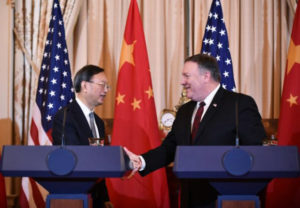US calls on China to remove missiles from Spratly Islands

US Secretary of State Mike Pompeo and Chinese politburo member Yang Jiechi shake hands following a press conference with during the US-China Diplomatic and Security Dialogue in the Benjamin Franklin Room of the State Department in Washington, DC, on November 9, 2018.
/AFP photo
For the first time, the United States called on China to remove missiles it deployed on three fortified outposts it built in the Spratly Islands in the South China Sea.
“The United States called on China to withdraw its missile systems from disputed features in the Spratly Islands, and reaffirmed that all countries should avoid addressing disputes through coercion or intimidation,” the Department of State released in a statement on Saturday (Philippine time) after the high-level US-China diplomatic and security dialogue in Washington.
Both US and China committed to supporting peace and stability in the South China Sea, the peaceful resolution of disputes, and freedom of navigation and overflight and other lawful uses of the sea in accordance with international law during the dialogue, it added.The US takes no sides in the territorial disputes in the South China Sea but has expressed interest in the peaceful settlement of the rival claims.
‘First time’
This is believed to be the first time that the United States directly addressed the deployment of the missiles, and also a first time it implied that it believed that the weapons were still on the artificial islands.
“This is the first time the US has indicated it believes the YJ-12s and HQ-9s China deployed to Spratlys in May are still there, not just a temporary deployment for exercises,” Gregory Poling, director of Asia Maritime Transparency Initiative (AMTI), said on Twitter.
The YJ-12B anti-ship cruise missiles will allow China to strike vessels within 295 nautical miles, while the HQ-9B long-range surface-to-air missiles can target aircraft, drones and cruise missiles within 160 nautical miles.
“AMTI and others have been unable to confirm that since China presumably kept them in shelters,” he said.
In May, US television network CNBC reported that China deployed antiship and surface-to-air missiles on Kagitingan (Fiery Cross), Zamora (Subi) and Panganiban (Mischief) Reefs, three of seven Philippine-claimed reefs that China had transformed into military outposts.
These three reefs, known as Big Three, are among the features claimed by the Philippines, China, Brunei, Malaysia, Vietnam and Taiwan. The deployment also meant that China has deployed weapons on the Philippines’ exclusive economic zone, Alexander Neill, Shangri-la Dialogue senior fellow for Asia Pacific security at the International Institute for Strategic Studies told the Inquirer in May.
“In practice, China now has the capability to deny the Philippines access in the air or at sea to the islands and reefs it claims,” he said.
Disclaimer: The comments uploaded on this site do not necessarily represent or reflect the views of management and owner of Cebudailynews. We reserve the right to exclude comments that we deem to be inconsistent with our editorial standards.
